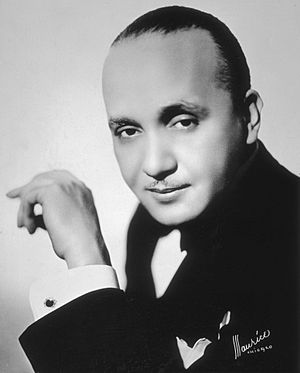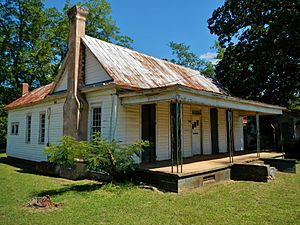Fletcher Henderson facts for kids
Quick facts for kids
Fletcher Henderson
|
|
|---|---|

Henderson in 1943
|
|
| Background information | |
| Birth name | James Fletcher Hamilton Henderson |
| Also known as | "Smack" Henderson |
| Born | December 18, 1897 Cuthbert, Georgia, U.S. |
| Died | December 29, 1952 (aged 55) New York City, U.S. |
| Genres | Jazz, swing |
| Occupation(s) |
|
| Instruments | Piano |
| Years active | 1921–1950 |
James Fletcher Hamilton Henderson (born December 18, 1897, died December 29, 1952) was an American musician. He was a talented pianist, bandleader, arranger, and composer. Henderson played a huge role in creating big band jazz and swing music. Many people consider him, along with Duke Ellington, one of the most important bandleaders and arrangers in jazz history. He helped connect the older Dixieland jazz style with the newer swing era. People sometimes called him "Smack" Henderson.
Contents
Early Life and Education

James Fletcher Hamilton Henderson was born in Cuthbert, Georgia. He grew up in a middle-class African American family. His father was a school principal. His mother was a teacher. She taught Fletcher and his brother Horace how to play the piano. Fletcher started piano lessons when he was six years old. His father sometimes made him practice for hours. By age 13, Fletcher was very good at reading music and hearing different pitches.
Even though he was a talented musician, Henderson first wanted to study math and science. When he was 18, he moved to Atlanta, Georgia. He changed his name to Fletcher Henderson. He went to Atlanta University. In 1920, he earned a degree in chemistry and mathematics. After college, he moved to New York City. He planned to study chemistry more, but he ended up working in music instead.
Start in Music
In New York City, Henderson shared an apartment with a pianist. This pianist worked in a band on a riverboat. One day, his roommate was too sick to play. Henderson took his place. Soon, he had a full-time job as a musician. In late 1920, he also started working for a music company. He realized that music could be more profitable than chemistry. So, he left his chemistry job to focus on music.
When the owner of the music company started Black Swan Records, he hired Henderson. Henderson became the musical director for Black Swan Records from 1921 to 1923. During this time, he mostly played piano for blues singers. He even toured with a singer named Ethel Waters.
Forming His Band
Until the end of 1923, Henderson mainly recorded music for different record labels. His band was mostly a group of musicians who came together just for recordings. It wasn't a regular band that played together all the time. But in January 1924, this recording band became the main band at the Club Alabam in New York City. This was Henderson's first regular working band.
In July 1924, the band started playing at the Roseland Ballroom. They were only supposed to stay for a short time. But they were so good that they were asked to come back. Henderson then asked cornet player Louis Armstrong to join his band. On October 13, 1924, Armstrong joined the band at Roseland. Henderson's band quickly became known as the best African American band in New York.
The band's music was arranged by Don Redman. He made sure there were more solo parts for the musicians. Armstrong played with the band for about a year. After Redman left the band in 1927, Henderson started doing more of the arranging himself. Other talented musicians like Benny Carter also helped arrange music for the band.
Success and Challenges
Around 1925, Henderson's band included famous musicians like Armstrong, Coleman Hawkins, and Buster Bailey. Henderson recorded many songs in the 1920s for almost every record label. He played at popular places like the Roseland Ballroom and the Savoy Ballroom in Harlem.
During the 1930s, he continued to record music. His band recorded 80 songs in 1924 alone. His version of the song "I Can't Get the One I Want" was released on at least 23 different labels! Many other great jazz musicians played with Henderson's band over the years. These included trumpeters like Henry "Red" Allen and Roy Eldridge, and saxophonists like Chu Berry.
Even though Henderson's band was popular, he wasn't very good at managing it. He wasn't well-known outside of New York. He was great at finding talented musicians, but he often lost them to other bandleaders. He also had money problems. In 1934, his band broke up. He had to sell some of his popular music arrangements to Benny Goodman to help his finances.
Working with Benny Goodman
After 1931, Henderson's own arrangements became very important. He wrote music for his own band and for other bandleaders like Benny Goodman. In 1935, Goodman's Orchestra was chosen to play on a radio show called Let's Dance. Goodman needed new music every week. His friend suggested he buy arrangements from Henderson.
Many of Goodman's biggest hits from the swing era were originally played by Henderson's band. Henderson would write down these songs and sell them to Goodman. Henderson's brother, Horace, said that Goodman asked for many new songs. The singer Helen Ward said that Henderson was happy to hear Goodman's band play his music so well.
In 1939, Henderson stopped leading his own band. He joined Goodman's band as a pianist and arranger. He later became a full-time arranger for Goodman. Henderson formed his own bands again a few times in the 1940s. He also toured with Ethel Waters again. In 1950, he had a stroke. This caused him to be partly paralyzed, and he could no longer play the piano. He passed away in New York City in 1952, shortly after his 55th birthday.
Contributions to Music
Fletcher Henderson, along with Don Redman, helped create the basic style for swing music. They divided the band into different groups, like the saxophone section and the trumpet section. These sections played together to make a special sound. Sometimes, the sections would play in a call-and-response style, where one group plays and another answers. Other times, one section would play background music while another played the main tune.
Henderson also played a key role in bringing Louis Armstrong from Chicago to New York in 1924. This helped make New York a major center for jazz music. He also helped bring the exciting, improvisational jazz styles from New Orleans to New York. There, these styles mixed with the dance-band tradition, which used a lot of written music.
Henderson created a band that could play both dance music and complex arrangements. One musician, Louis Metcalf, said that seeing Henderson's band play with music stands made many people in Harlem want to learn to read music. A museum was created in Henderson's honor in his hometown of Cuthbert, Georgia.
Selected Discography
- A Study in Frustration, Columbia, 1961
- Hocus Pocus, Bluebird Records, 1992
- Tidal Wave, GRP, 1994
- Ken Burns Jazz: Fletcher Henderson, Columbia/Legacy, 2000
- Sweet and Hot, Le Chant du Monde, 2007
- First Impressions 1924–1931 Vol. 1, Decca Jazz Heritage Series, DL 9227
- Swing's the Thing 1931–1934 Vol. 2, Decca Jazz Heritage Series, DL 79228
As arranger for Benny Goodman Orchestra
- Sing, Sing, Sing (1992) (Bluebird/RCA)
- The Harry James Years, Vol. 1 (1993) (Bluebird/RCA)
- The Best of the Big Bands [under Goodman's name] (1933-1946/1989) (Columbia)
- Genius of the Electric Guitar (Recorded under Goodman sextet's name, released under Charlie Christian's name) (1939–1941/1990) (Columbia)
Images for kids
See also
 In Spanish: Fletcher Henderson para niños
In Spanish: Fletcher Henderson para niños


